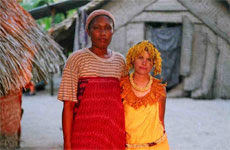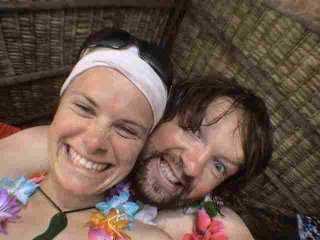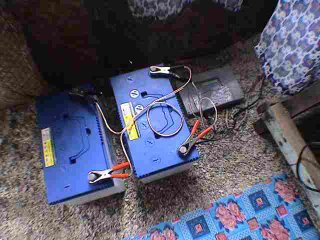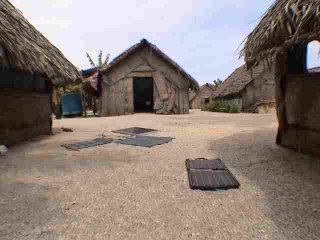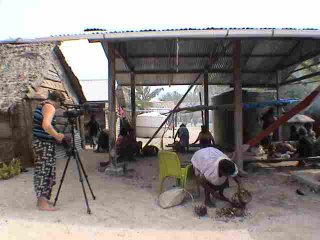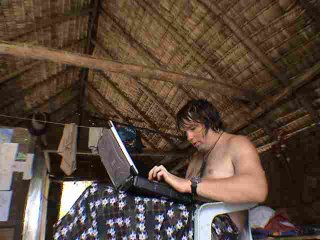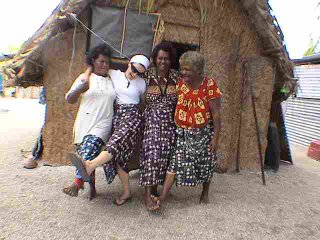Contemplating the joy of sailing and the sadness of leaving, Zane has written the following. For a final taste of Takuu keep reading to the bottom. The final departure seems to me as tragi-comic as the initial one from New Zealand but, really, much more moving...
Ahhhh the Sankamap... It probably seems strange how much we refer to the ship in the blog and the fact that we do so by name. But once you've been here and seen how important this ship is and how its very character influences the lives of so many, you quickly start to think of it not so much as a thing but as a living breathing being. She was built for the PNG government around 18 years ago (I'll try and check this date the ship looks and probably is older), specifically so that the Atolls could be regularly serviced, and the plan worked well for a while...For a while it was a great little cargo ship that was air-conditioned, had a cook for the cabin passengers and a working shower. It could take about 130 passengers and, I would estimate, about 50 tonnes of cargo.
However from the outset it was doomed. It was originally designed with two cargo holds and two loading cranes, but then in order to save a few million Kina the decision was made to reduce its length by 10 metres. That reduction in length was achieved by simply cutting out one of the cargo holds and cranes. The money saved supposedly disappeared into some dodgy individual's pocket never to be seen again. As a result, the ship can't really carry enough cargo to be economically viable and, what's more, its sea handling has been ruined by the fact it’s so much shorter than it was designed to be and hence it doesn't ride very well. If you look at the photo of it you'll notice how stubby it seems to look due to the missing length in between the bow and the superstructure.

Despite being handicapped at birth, the Sankamap has had a busy and colourful life. She was used to run troops around during the crisis and even played a role in repelling rebels when they attempted to invade Buka Island from Bougainville by crossing the narrow Buka passage. Armed troops lined the side of the ship, which was tied up on the Buka side, and waited silently while the rebels attempted a night crossing. Then when the rebels were mid passage the troops opened fire. I don't know many details of the event but I can imagine it was a bit of a slaughter. The Sankamap got a bullet hole to show for her part in the successful ambush. This story is one of the seemingly endless supply Richard had about the ship.
The Sankamap has been the main lifeline to the Atolls off Bougainville for the last 20 years. At present management of the ship is in the hands of a company from Nukumanu (Tasman Island, one of the Atolls around Takuu). I'm still unsure as to whether the actual ownership of the vessel is in the hands of the company or the government but nevertheless there are a lot of people unhappy about the current set up.
You would assume that with control of the vessel lying in the hands of people from the Atolls the islands would be getting good service. However this is not the case, as the ship now has to put profit first in order to survive whereas before, while profit may have been nice, the first duty of the ship under her government-run management was to provide a service and that service was aimed at looking after the residents of the five outlying atolls. Under the new regime and its need to try and generate profit, the quality of the service to the islands has reduced and servicing and maintenance of the ship has sunk to the bare minimum. Gone are the air-conditioning and any of the creature comforts enjoyed by passengers in years past. The ship has numerous rust holes, many of which are dangerous for the passengers, and others I suspect seriously affect the seaworthiness of the ship.
The Sankamap regularly runs to Buka, Rabaul and Lae but only infrequently to the Islands as it has to try and earn enough in order to be able to afford what is a loss-making trip. As the most isolated of all the Atolls, Takuu suffers the worst from this fact. In the case of the other islands, either the Bougainville mainland or the Solomans are within fairly easy reach, but Takuu, in the middle of the atoll group, has no easily access to off-shore facilities for getting supplies or in case of emergencies.
In case we haven't mentioned it in previous entries, the Sankamap is pigeon for Sunrise and it is literally pronounced “Sun come up”. Despite the positive name, this ship is probably the single biggest problem that the Atolls face. A regular and well run service to the islands would create the ability for the islanders to set up their own businesses. These would help them to fund the ship’s trips to the Island and to fund and import better amenities for the island such as medical and educational supplies. It would also reduce their dependency on hand-outs from the cash starved Bougainville government. It would open the doors for tourists to visit and stay upon the Islands which would be a much welcomed economic boost. At the moment Takuu would by very lucky to get four Sankamap visits a year and has had to go up to seven months without a visit, meaning food and fuel supplies on the island are exhausted and if anyone has gotten seriously sick they are quite simply dead. The ship will not do mercy trips to the island so if you get sick and your family can't raise the 9,000-18,000 Kina (NZ$4,500 – 9,000) needed to pay for a trip you die. No ifs or buts - you die... they do a brief ceremony and put you in the ground before your body goes off in the heat.
So yes - the Sankamap is about as important as a machine can possibly get and yet due to a huge range of factors (many of them political and hence off limits to mention in a public forum) she is dying and while various people try to get an alternative vessel set up; none at this point exists so the ship remains the only lifeline for the Islands in the truest sense of the word 'lifeline'.
With all this knowledge we finally boarded the ship to leave Nukutoa Island in Takuu...
After waiting for so many days for the ship to come we got caught out by the fact that when it did, it actually arrived several hours early. I wrote this on the day that we left Takuu:
Briar is off getting shots of the kids at school which has started yesterday while I am frantically dismantling and packing all our gear deciding as I go what we really need to take and what can be given to the Islanders. I’m frantic because the ship is coming at 1pm and it is now 9am and there is much to do especially as we need to shoot an interview with the school principal at 10am which will take at least 30 mins. Suddenly Richard walks in and tells me the ship is in sight and be ready to go at 11am. He also adds a reminder that it can't anchor so please make sure we're ready in time as it would be most embarrassing if not actually impossible for it to wait for us. This sends me running through the village looking for Briar... No sign of her anywhere..Damn...
Rush back, keep packing, then Briar is there, phew! She's been filming Endar's leaving prep. I tell her the problem then we both pack like mad doing our best to make everything as watertight as possible due to the fact we know we will be boarding a moving ship from a banana boat. Abruptly Sio walks in, are we ready he asks? The boat is here waiting to take us to the ship. Suddenly as we shove the last items in bags, the bags themselves are being grabbed by many different hands and disappearing from the house. I try to do a last check to see what we have missed but it's cursory as I am practically dragged out the back of our house to where the banana boat sits in the water loaded and ready to go. People I know are surrounding me saying goodbye. It is a sea of confusion and emotion as we shake hands hug and kiss everyone. In the background we can hear a child screaming - grief stricken as his grandmother boards our boat to leave. Briar is close to tears as are some of the ladies. Even the usually staunch Sio looks a little weepy. The ship is slowly moving past the island a few hundred metres off shore, her presence adding fuel to the mad inferno of rushed farewells we seem to be caught in.
Avo the Chief is there happily shaking our hands, his gnomelike face smiling in appreciation of our visit. I'm feeling almost dizzy as I try to remember the names and faces before me and say goodbye appropriately. Then we're in the banana boat and heading away from the island and all is silent but for the throb of the outboard and the sobs of the grandmother. Briar and I look at each other kind of shellshocked. Is that it? After nearly two months here, are we really going? The last 10 minutes of machine gun farewells seemed both surreal and deeply moving...Did all that really happen?
The ship looms over us and then we're on board. Our gear is quickly stowed and we're on deck looking back at the islands as the last of the banana boats with the other passengers arrive. Rose is with us and pulls out food prepared for our trip. At first it looks like cooked coconuts but when cracked open they reveal that they are stuffed with rice and Karave; the sweet sap of the coconut tree. All this has been cooked in the shell so that the coconut flesh, the milk, the rice and the Karave have all caramelised into a deliciously sweet treat. We eat this, still warm from cooking, with sticky fingers as the ship finishes loading and swings her nose towards the reef and towards the passage through to the awaiting Pacific.
We’re set for 20 hours to Buka upon a ship that is probably overloaded and on which the liferafts are six years past their service dates, the toilets are places you avoid going at all costs, and every surface is covered in a thin layer of grime and rust, meaning that very quickly we are getting filthy...and yet we are happy
We have a long way to go... but we have started heading home.
A week in Buka lies ahead; a small frontier-like town on the edge of civilsation in a newly formed nation that has arisen from a long and bloody civil war... Should be fun!
Zane out.

It's toilet time...
